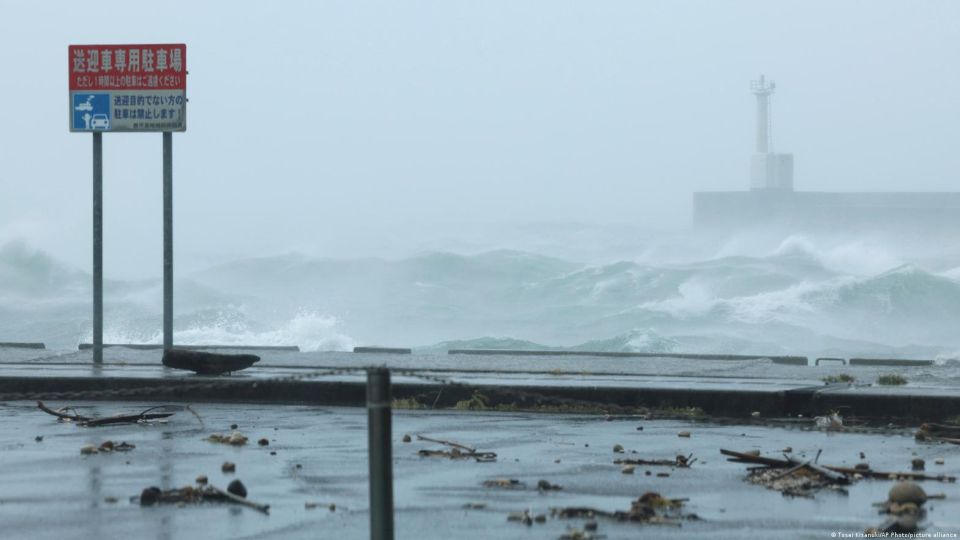- Typhoon Nanmadol hit western Japan this Monday (09.19.2022) with heavy rains and winds, leaving more than 300,000 homes without electricity and forcing airlines to cancel their flights and interrupt the operation of trains.
Millions of people were under evacuation alerts on Monday as Typhoon Nanmadol unloaded strong winds and heavy rain on the southwestern part of the country after making landfall the night before.
Evacuation alerts at various levels remained in place for 9.6 million people on the last day of a holiday weekend in Japan. The alerts do not force people to evacuate, and authorities sometimes have to convince people to leave their homes during extreme weather events.
The powerful cyclone lost strength late Sunday when it made landfall near the city of Lakoshima in the southwestern region of Kyushu, but uprooted trees, shattered windows and left rivers close to bursting their banks.
NHK television reported that one person was killed and 50 others were injured as the storm passed through Kyushu. Authorities did not initially confirm the figures. But the damage seemed relatively minor, given the intensity of the storm.
By 1100 (0200 GMT), the typhoon was moving north-northeast near Kitayushu, Kyushu’s northernmost city, with maximum winds of 162 km per hour, according to the weather service.
NEW: Dangerous Typhoon Nanmadol makes landfall in Japan: weather agency https://t.co/hToQwG29f5
Footage via (RT) pic.twitter.com/smbKIjBsHa
— Insider Paper (@TheInsiderPaper) September 18, 2022
Since the rains caused by the typhoon began, Miyazaki prefecture, in southern Kyushu, has already accumulated 1,000 millimeters of rainfall, an unprecedented level, according to NHK public television.
Authorities warned of flooding and landslides as the season’s 14th typhoon moved east of Japan.
They ask to continue attentive to the effects of the meteor
Up to 400 millimeters of rain is expected in the central Tokai region, the nation’s industrial heartland, in the next 24 hours, the JMA said.
“We have to remain very vigilant for heavy rains, gale force high waves and storm surges,” an agency official told a news conference.
Kyushu Railway Co, the train operator serving the western Japanese island of Kyushu, said it had halted operations throughout Monday, while carriers Japan Airlines and ANA have canceled some 800 flights for the day. NHK reported.
Typhoon moves slowly
The slowness with which the storm is advancing, barely 15 kilometers per hour, and its large size, have been leaving abundant rainfall in most of the Japanese archipelago for days and, in addition to Miyazaki, the alert has been activated for rivers in danger of overflow in those of Oita and Kumamoto, also in Kyushu, and Yamaguchi, in the extreme west of the island of Honshu, the main island of the country.
Typhoon Nanmadol warning issued for S. Korea's southeastern regions#Typhoon #Nanmadol #Arirang_News pic.twitter.com/6nB7A7ch0s
— Arirang News (@arirangtvnews) September 19, 2022
Nanmadol forced the JMA on Saturday to activate for the first time the maximum typhoon alert for one of the four main islands of the archipelago, an alert that is maintained by winds, rainfall and waves that the JMA considers to be unprecedented in the country.
The JMA predicts that the typhoon will move throughout the day in a northeasterly direction over the prefectures of Yamaguchi and Tottori, in Honshu, and that it will travel through much of the western Japanese coast during the night.
The storm has already forced the suspension of domestic flights to or from Kyushu for the last three days, where practically all rail transport is suspended, and has also meant that bullet train services linking the cities of Fukuoka, Hiroshima and Osaka, including those that extend services to Nagoya and Tokyo, both in the center and east of the country.
🎞️ How do tropical storms form? 🌪️💦 #typhoon #Nanmadol pic.twitter.com/MWYz0oVRiO
— DW Science (@dw_scitech) September 18, 2022

